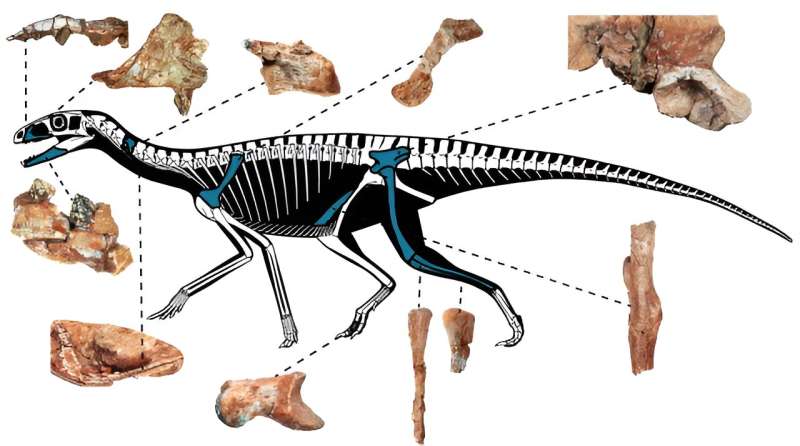This article has been reviewed according to Science X's editorial process and policies. Editors have highlighted the following attributes while ensuring the content's credibility:
fact-checked
peer-reviewed publication
trusted source
proofread
New fossil assemblage highlights complexity of classifying silesaurid phylogeny

A set of fossils recovered in Rio Grande do Sul, Brazil's southernmost state, has brought an extra layer of complexity to the study of the evolutionary history of silesaurids, a family of dinosauriforms (dinosaurs and their close relatives) that lived in the Triassic period between 247 million and 208 million years ago.
In an article published in the Journal of Vertebrate Paleontology, researchers affiliated with institutions in Brazil and the United States show that even with the new fossil assemblage it is difficult to confirm that these animals were part of the evolutionary history of the dinosaurs.
The fossil assemblage was found in 2014 at a site called Waldsanga in the Santa Maria Formation, one of the most fossil-rich rock bodies in Brazil. The bones belonged to more than one individual, and it is impossible to be sure they all belonged to the same species, although the evidence suggests they did. Above all, it is an essential record of animals that lived in the area during the Triassic.
The assemblage is the fourth find relating to silesaurids in Brazil and the second from the Carnian age (237-227 mya). It is labeled UFSM 11579 and is deposited at the Stratigraphy and Paleobiology Laboratory of the Federal University of Santa Maria (UFSM).
"When we inserted the assemblage's characteristics into various phylogenies [evolutionary histories] of the group, we didn't specify whether the silesaurids were dinosaurs or close relatives of dinosaurs. In any event, the anatomical and phylogenetic evidence validated the find as belonging to the silesaurid lineage, albeit not named as a new species," said Gabriel Mestriner, first author of the article.
"Because the bones are disarticulated, and considering the uncertainty about the group's evolution, we concluded that adding another species in this case wouldn't be a solution but would make the problem worse," Mestriner said.
The silesaurids were mostly quadrupeds and 1m to 3m in length. They had long hind legs, and their front legs were slender. Remains have been found in present-day South America, North America, Africa, and Europe.
The first species, described in 2003, was Silesaurus opolensis. Its remains were found near Opole in Silesia, Poland—hence the name. "It's the species with the most complete skeleton to date. In addition, the find comprised several hundred well-preserved bones relating to several individuals. About ten more species have been described since then, but their remains were more fragmented," said Júlio Marsola, second author of the article.
The study was part of the Thematic Project "Dinosaur diversity and associated faunas in the Cretaceous of South America," led by Max Langer, a professor at FFCLRP-USP and the last author of the article.
"Although many species have been described on the basis of few bones, the main problem with this group isn't lack of material, but ambiguous anatomy: parts of the skeleton are similar to the dinosaurs, others less so. It's difficult to resolve their phylogenetic relationships," Langer said.
Different teeth
In another study, published in 2021, the researchers focused on dental anatomy to look for fresh evidence of the silesaurids' place in the dinosaur family tree. Their analysis of tooth attachment and implantation in four species, including UFSM 11579, concluded that these species' teeth mainly were fused to the jawbone, lacking the periodontal ligament (the soft connective tissue between teeth and bone) present in dinosaurs and extant crocodiles.
"At the same time, however, some of the teeth we analyzed were anatomically closer to those of dinosaurs and crocodiles, as if the silesaurids were evolving in that direction. If so, they could represent an intermediate stage between the ancestral condition [fused teeth] and the derived condition [teeth anchored to alveolar bone sockets by ligaments]," said Mestriner.
The new dental configuration, which is also seen in humans and other mammals, is considered an important evolutionary advantage for ancestral non-mammals since periodontal ligaments act as shock absorbers that help reduce the mechanical impact of biting and chewing.
The findings on dental implantation are not sufficient to differentiate silesaurids from other dinosauriforms but make it more likely that they are very closely related to dinosaurs. For Langer, who was the principal investigator for both studies, understanding the groups' evolutionary history is more important than continuing to name new species and can be achieved using the existing data, such as fossils deposited in museums.
"We need more detailed phylogenetic studies by researchers who scrutinize collections to analyze all fossils in a group in pursuit of characteristics that point to kinship within the group or with other groups. The databases we have now are the result of this kind of research, of which there hasn't been enough. It's hard work, but we won't move forward without it," he said.
More information: Gabriel Mestriner et al, Anatomy and phylogenetic affinities of a new silesaurid assemblage from the Carnian beds of south Brazil, Journal of Vertebrate Paleontology (2023). DOI: 10.1080/02724634.2023.2232426
Journal information: Journal of Vertebrate Paleontology
Provided by FAPESP





















